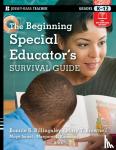Stel een vraag
Ik heb een vraag over het boek:
‘A Survival Guide for New Special Educators - Billingsley, Bonnie S. (Virginia Tech), Brownell, Mary T. (University of Florida), Israel, Maya, Kamman, Margaret L.’.
Vul het onderstaande formulier in.
We zullen zo spoedig mogelijk antwoorden.


